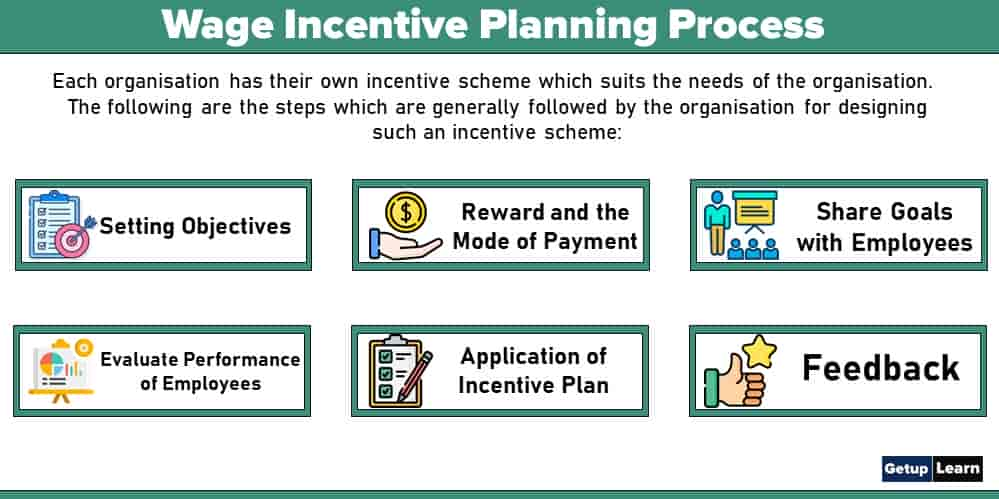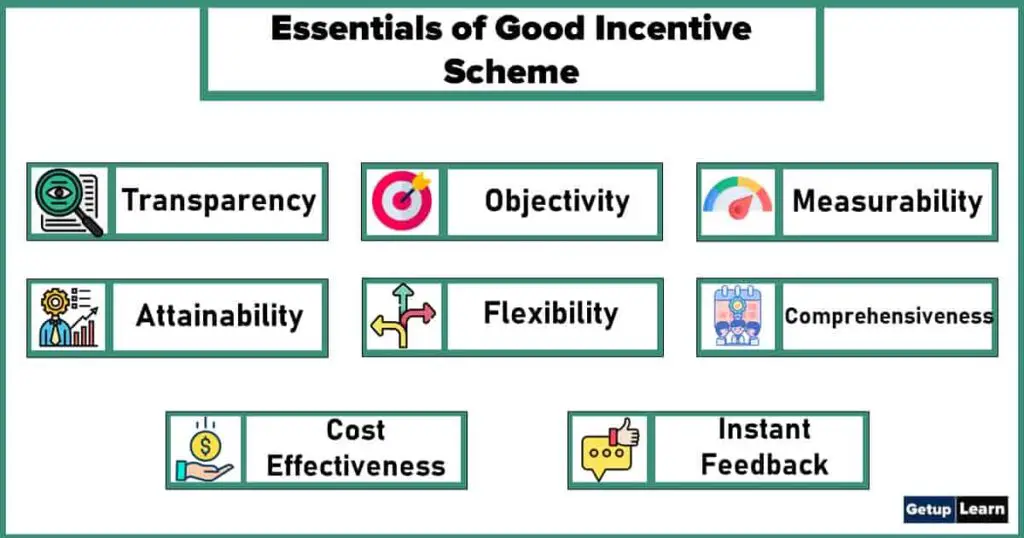Table of Contents
What are Wage Incentives?
Wage incentives can be defined as variable rewards granted according to the achievement of a specific result.

The basic philosophy behind an incentive scheme is that any person who works hard will be able to earn more. The incentive that the employees get is in addition to the base wage that they get. The incentives are provided for enhancing the organisational performance and the productivity of the employees. Through wage incentive programs, the organisation establishes a formal relationship between the performance of the employees and the pay that they get.
But when the rewards offered through such programs do not fulfil the needs of the employees, then the rewards offered cannot be considered incentives. The incentive programs should be designed in such a manner that the exact needs of the employees are fulfilled.
The incentive provided is according to the performance of the employee. So it is essential that the organisation has a sound performance appraisal system so that appropriate incentive are provided to the people who have performed in a better manner than others.
Objectives of Wage Incentives
The primary objective of wage incentives is to attract and retain employees who are efficient and motivate them to work harder. The following are the other objectives of wage incentive schemes:
- Wage incentive schemes aim to develop a sense of personal interest among the employees of the organisational affairs which helps them in developing a sense of responsibility towards the organisation.
- Through wage incentive programs, the organisation aims to motivate the employees.
- Wage incentive programs also aim at controlling employee turnover and employee dissatisfaction.
- It also enables the employees to decide their own pay. The base pay of all is fixed. The wage incentive program allows the employee to earn income above the base pay that has been fixed.
- As the wage incentive program establishes a link between pay and productivity, the performance and productivity of the employees increase.
- As wage incentive programs link productivity with pay, the cost of supervision is reduced as employees would work with caution and a sense of responsibility. Further, this also leads to a reduction in the cost of labour as through such schemes, a permanent increase in wages need not be declared by the organisation.
Wage Incentive Planning Process
Each organisation has their own incentive scheme which suits the needs of the organisation. The following are the steps which are generally followed by the organisation for designing such an incentive scheme:
- Setting Objectives
- Determine the Nature of Reward and the Mode of Payment
- Share Goals with Employees
- Evaluate the Performance of Employees
- Application of Incentive Plan
- Feedback

Setting Objectives
In the first step in the process of designing an incentive scheme, the goals for such incentive schemes have to be established. For this, the organisational objectives can be taken as a base. This would help the organisation to determine which goals are to be achieved and how they can be achieved through the employees with the help of such schemes. This has to be done so that the employees believe that such goals which have been established can be achieved by them.
In order to do so, the organisation can design group incentives or individual incentives. It is essential that such goals are revised periodically so that a continuous improvement in the performance of the employees can be observed.
Determine the Nature of Reward and the Mode of Payment
Once the goals have been established, then the type of incentive and its mode of payment has to be determined. For this, the total compensation payable for accomplishing the set goals has to be first determined. Further, the organisation also has to decide whether such incentives would be group incentives or individual incentives as well as the decision regarding the nature of the reward also has to be done.
Such incentives may be monetary incentives or non-monetary incentives. In order to make a decision regarding these aspects, the merits and demerits of each and every aspect have to be studied.
Once the goals, mode and nature of incentives are determined, the information regarding the goals and objectives have to be communicated to the employees in such a manner that they are able to easily understand them.
Any query which might be in their mind has to be addressed by the management so that the incentive plan could be implemented without any issue. This also ensures that the employees believe that the organisation is actually offering a reward for the efforts that they are making towards the achievement of the goals set up by the organisation.
Evaluate the Performance of Employees
After a certain period of time, the organisation must evaluate the performance of the employees’ to determine whether the standards as decided by the organisation have been achieved by the employees of the organisation or not.
It should be kept in mind that the performance appraisal of the employees is undertaken for many other reasons as well and the fixation on wage incentives is among the various reasons. On the basis of the objectives of the performance appraisal the method of appraisal would be fixed and the performance of the employees would be evaluated.
Application of Incentive Plan
Once the performance appraisal process is completed, the organisation has to apply the appropriate incentive plan for paying the employees according to their performance. At this stage, the employees would be able to understand what their pay would be.
The organisation should ensure that the employees should be paid according to the efforts made by them so that the basic purpose of establishing an incentive plan would be achieved.
Feedback
It may be possible that few of the employees are not satisfied by the incentive plan which has been put in place by the organisation. In such situations, the incentive plans instead of motivating the employees may leave them dissatisfied. This may result in increased labour absenteeism and high labour turnover.
To avoid such issues, it is important that the organisation reviews the incentive programs established by it in a periodic manner. This would enable the organisation to determine the fairness and efficiency of the incentive plans and undertake any revisions in the schemes in a timely manner.
Essentials of Good Incentive Scheme
In order to implement an effective incentive plan in an organisation, appropriate planning has to be undertaken. The organisation should ensure that the incentive scheme introduced by it is effective by fulfilling the following conditions:
- Transparency
- Objectivity
- Measurability
- Attainability
- Flexibility
- Comprehensiveness
- Cost Effectiveness
- Instant Feedback

Transparency
Before implementing an incentive scheme, the organisation should ensure that the incentive scheme which is being implemented is transparent and understandable to all. In order to do so, highly technical and complex terms should be avoided. This helps the employees to trust the incentive scheme which has been designed by the organisation.
Objectivity
For designing an incentive scheme, the aspects which are covered should not be subjective but should be objective. This ensures that personal bias and prejudices do not affect the incentive schemes. This would also assure that the employees do not feel that the incentives are distributed in an unfair manner. It would ensure that the incentive scheme is equitable and fair to all the employees of the organisation.
Measurability
Any incentive scheme which is to be implemented by the organisation should be quantifiable. Such a measurement scheme should be based on a rational and scientific basis. Abstract terms such as the attention of employees required level of concentration and stress level should be avoided for determining the incentives which the employees would receive.
Attainability
The performance goals which are fixed by the organisation should be such that they are practical and achievable by the employees. If the goals which are fixed by the organisation are very tough to achieve, then the employees may feel the need to achieve such goals.
They might, in future, also become indifferent toward the various goals of the organisation. In order to avoid such situations, the employees should be involved while determining the goals which would ensure that the goals are practical and achievable.
Flexibility
An incentive scheme which is designed by the organisation should be flexible enough to adapt itself to the changing situations in the organisation. Those who are implementing the scheme should ensure that necessary changes should be made to the scheme before it is too late.
Comprehensiveness
An effective incentive scheme should be such that there is some incentive in it for everyone. It should ensure that employees of all levels must be covered. With the total cooperation of the employees and the trade unions, an incentive scheme can be successfully implemented.
Cost-Effectiveness
An incentive scheme is effective only when it is economical as regards the goals which are aimed to be achieved by using them. For e.g. when pay is linked with the performance of the employees, the management aims to make production cost-effective.
But it might be possible that maintaining such a scheme may be more costly than the benefits that are being availed. As a result, at such times, the management should ensure that such incentive plans are replaced with more effective schemes which are economical to maintain.
Instant Feedback
Incentive schemes which are designed should be such that the reward that the employee is supposed to get is immediately received by them. This would ensure that the employees work in a determined manner in order to achieve the goals that are fixed under the incentive scheme which is designed by the organisation.
Benefits of Incentives
The following are the various benefits of incentives schemes:
- As the pay of the employees is directly linked to their performance, the employees can claim a higher income when their performance and productivity improve.
- Incentive schemes do not create any permanent burden on the resources of the organisation as the increase in the wages of the employees might just be temporary instead of a permanent increase in the wages of the employees.
- The incentive schemes create a sense of responsibility among the employees as in order to improve their pay, the employees try to work in a more efficient manner. This is so because as the pay of the employees is linked with their performance, the employees try to improve their own performance for earning a higher income.
- The incentive schemes which are implemented ensure that all the resources of the organisation are used to their optimum level as utilization of the resources of the organisation ensures that the earning potential of the employees also increases.
- As the employees have the ability to control the level of their pay, they cannot hold the organisation responsible for the lower pay earned by them. As a result, the organisation might be able to reduce labour absenteeism as well as labour turnover.
- The friction between the employees and employers which arises due to fixation on pay could be avoided as the pay which is earned by the employee is based on the productivity of the employee.
Limitations of Incentives
The following are the limitations of incentive schemes:
- It might be possible that the quality of the goods produced may be compromised as it might be possible that the employees in order to earn more may neglect the quality of the products which are produced. As a result, an incentive scheme which was implemented for reducing the cost of production might lead to an increase in it by increasing the number of goods which do not successfully pass the quality control checks undertaken by the organisation.
- As the pay of the employees is linked with the performance of the employees, it might be possible that the employees may feel that any reduction in the pay of the employees might be an indication of their poor performance. So in such instances, instead of accepting their own poor performance, the employees may start blaming the incentive scheme of the organisation as defective.
- It may also be possible that in order to avoid paying incentives to the employees, the management fixes performance goals which are very high. As a result, it might be possible that even after many efforts of the employees; they might not be able to achieve the targets fixed by the organisation.
- The incentive schemes which are in place in the organisation could also become a cause of disruption of unity among the employees when they see that few employees are able to earn higher pay than others on the basis of their efficiency in performance. This might result in the creation of a feeling of jealousy and enmity among the employees of the organisation.
- When the employees try to work hard to improve their performance, it might be possible that they might physically and mentally exhaust themselves. As a result, the health of the employees might be adversely affected.
- Incentive programs might be used by the management to exploit the employees in an unethical manner without having any concern for the future security of the employees.
What is the meaning of wage incentives?
Wage incentive may be defined as the stimulation of efforts and effectiveness by offering monetary inducements or enhanced facilities.
What is the process of incentive?
These are the following steps of the wage incentive planning process:
1. Setting Objectives
2. Determine the Nature of Reward and the Mode of Payment
3. Share Goals with Employees
4. Evaluate the Performance of Employees
5. Application of Incentive Plan
6. Feedback etc.
What are the essentials of a good incentive scheme?
The following essentials of a good incentive scheme:
1. Transparency
2. Objectivity
3. Measurability
4. Attainability
5. Flexibility
6. Comprehensiveness
7. Cost-Effectiveness
8. Instant Feedback etc.















